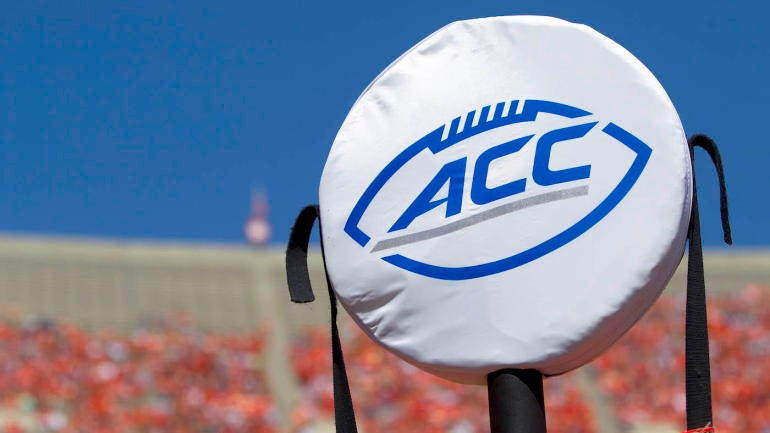
Stanford, California and SMU will be joining the ACC, bringing the conference to 18 members, the league announced on Friday. ACC presidents met on Friday morning and voted in favor of the additions and the conference board of directors formally approved the schools' applications shortly thereafter. SMU will join as a member of the ACC on July 1, 2024, while Stanford and Cal will arrive in the conference a few days later on Aug. 2.
Stanford and Cal enter the ACC from the Pac-12 taking reduced media rights revenue shares of around 30%, according to Yahoo Sports. Both will contribute portions of its revenue back to the conference with the amount dwindling over time until the 10th year. SMU, meanwhile, will forgo ACC media rights revenue for its first nine years as a member moving from the American, sources confirmed to CBS Sports. The Mustangs will still receive College Football Playoff, NCAA Tournament and bowl game monies distributed to the league.
"The university will receive a full share of all revenues, including media revenue, while contributing back a portion of its media revenue to support and strengthen the conference and its current member institutions," Cal said in a statement. "UC Berkeley's membership contribution will taper off until the 10th year, at which point it will begin retaining 100% of its media revenue share. The fact that annual revenue will increase over time was an important factor in the agreement."
"We are thrilled to welcome three world-class institutions to the ACC, and we look forward to having them compete as part of our amazing league," said ACC commissioner Jim Phillips. "Throughout the evaluation process, the ACC Board of Directors, led by President Ryan, was deliberate in prioritizing the best possible athletic and academic experience for our student-athletes and in ensuring that the three universities would strengthen the league in all possible ways. Cal, SMU and Stanford will be terrific members of the ACC and we are proud to welcome their student-athletes, coaches, staff and entire campus community, alumni and fans."
The ACC is expected to receive around $72 million in additional media rights revenue as a result of expansion, per multiple reports, with $50 million to $60 million of that revenue being made available for the ACC to distribute as part of either a revised financial model or incentive program.
All three schools, along with the rest of the league, may be eligible to earn additional revenue based on incentives tied to success in major sports, specifically football and men's basketball. An incentive distribution model is still under discussion by the ACC, but many expect one to be formally introduced for the 2024 athletic season.
Four league members -- Clemson, Florida State, North Carolina and NC State -- were initially opposed to ACC expansion. League bylaws required 12 of 15 voting members (including Notre Dame) to vote in the affirmative for expansion to be approved. NC State flipped its vote in favor of the additions, according to multiple reports.
Stanford, Cal and SMU are seen as a buffer against a clause in the ACC's current media rights deal as ESPN has the right to renegotiate the league's contract should membership falls below 15 schools, according to Action Network. Seven ACC schools have been openly examining the league's grant of rights to look for exit opportunities, so adding three schools would allow the conference to remain above the 15-member threshold should there be some departures.
While the Big Ten has stretched the bounds of geographic normalcy during its wild expansion phase, Bay Area schools joining the Atlantic Coast Conference is notable in its own right. The closest school to the Bay Area is Louisville, which sits nearly 2,000 miles away. The majority of road trips will involve six-hour flights and 20-mile drives to major airports. SMU is a slightly less nightmarish situation as it is located in Dallas -- a flight hub in the middle of the country -- though it will still be a trek for many ACC opponents.
The ACC is citing expansion into significant markets of the Bay Area and Dallas as a key part of their decision. Stanford and Cal were not originally taken by the Big Ten because the Bay Area was seen as overrated in terms of TV demographs, an industry source told CBS Sports. The Big 12 already has multiple programs in the Dallas-Fort Worth area.
Stanford and Cal are more of a cultural fit than a financial one for the ACC. Both schools are members of the prestigious American Association of Universities. The designation brands the best research institutions in the country. Six of the 15 current ACC schools are in the AAU.
The Stanford-Cal football game is one of the sport's oldest rivalries. The Big Game -- as it is called -- has been played 125 times, the most famous meeting coming in 1982 with Cal winning 25-20 after a series of laterals in what was Stanford Hall of Famer John Elway's last game before heading to the NFL.
July 1, 2024, has now truly emerged as the beginning of a new era in college football. The Pac-12 is expected to fold once its grant of rights expires that day, while the SEC, Big Ten, Big 12 and now ACC are all poised to grow. Additionally, the 12-team College Football Playoff format debuts during the 2024 season.
Smooth landing
Even at a reduced revenue number, landing in a Power Five conference allows Stanford and Cal -- two of the nation's most respected academic brands -- to continue prominent levels of competition for their vast array of Olympic sports. More than 100 Stanford and Cal athletes participated in the 2020 Olympics.
The Cardinal play more varsity sports than any other school that participates at the FBS level, winning 26 Directors' Cups signifying their mix of athletic excellence with their academic success. (In fact, Stanford sponsors 36 collegiate sports -- across five conferences -- and has the same number of Nobel laureates, 36.) Jim Harbaugh and David Shaw elevated Stanford football to national prominence from 2007-22. In that span, the Cardinal finished six times among the top 12 teams in the AP Top 25, playing in five New Year's Six bowls across the most successful period in program history.
Cal, the state's first land-grant university established in 1868, is home to 29 Nobel Prize winners and 11 Pulitzer Prizes. Football was most successful under the legendary Pappy Waldorf, who went 29-3-1 from 1948-50. Jeff Tedford is the winningest coach in school history (82 victories) riding quarterback Aaron Rodgers to a 10-win season in 2004.
SMU last was in a major conference in 1995, the final year of the old Southwest Conference. It is home to Heisman Trophy winner Doak Walker and Pro Football Hall of Famer Eric Dickerson. The program is probably most famous behind handed a "death penalty" by the NCAA in 1987 after a widespread pay-for-play scheme was discovered. In many ways, the Mustangs never recovered until Friday.
For SMU, being elevated to the Power Five level is a culmination of over a decade of work. Since hiring June Jones as coach in 2008, the Mustangs have slowly but surely climbed their way back into relevance under the direction of not only Jones but Chad Morris, Sonny Dykes and now Rhett Lashlee. Moving to the Power Five gives SMU an air of relevance in recruiting and a pathway to contention with those around the team hoping the ACC can unlock a new ceiling for the program.
Left behind
With Stanford and Cal's impending move, Oregon State and Washington State are the only remaining members of the legacy Pac-12 without soft landing spots. The pair have received interest from both the Mountain West and AAC for membership but have also explored attempting to rebuild a conference under the Pac-12 branding.
When the Pac-12's grant of rights ceases to exist, so does the Pac-12. So, time is ticking for the pairing to finalize plans in the coming weeks. A source tells CBS Sports that Oregon State's preference is to rebuild the Pac-12, but having only two remaining schools could make that process difficult.





















